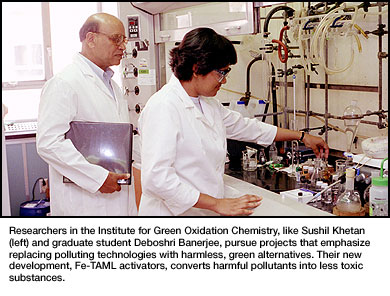|
|
||
|
|
|
 Chemists Develop "Green" Catalysts To Eliminate Toxic Residue � � Terry Collins, Carnegie Mellon's Thomas Lord Professor of Chemistry, has developed environmentally safe oxidation catalysts that can be used to decontaminate biological weapons like anthrax and eliminate toxic residues produced by several industries. Members of Collins' laboratory presented the latest findings on this work at the recent American Chemical Society (ACS) meeting in New York City. The oxidation catalysts, called Fe-TAML® (tetra-amido macrocyclic ligand) activators, are made from elements found in nature and work with hydrogen peroxide to convert harmful pollutants into less toxic or harmless substances. Fe-TAML research is the keystone of Collins' work. Collins heads Carnegie Mellon's Institute for Green Oxidation Chemistry (IGOC) in the Mellon College of Science. The IGOC pursues research, education and development of holistic approaches in green chemistry and emphasizes replacing polluting technologies with harmless, green alternatives. Fe-TAMLs could potentially be used to replace chlorine-based oxidants in large global technologies, eliminating the production of toxic industrial residues. The activators also show great promise to address problems such as general water purification. At the ACS meeting, Collins and his research group discussed Fe-TAMLs' effectiveness in killing an anthrax simulant—a harmless form of the deadly biological warfare agent commonly used in the laboratory for testing agents designed to eliminate its more deadly cousin. "In our laboratory tests, Fe-TAMLs are highly promising in cleaning up an anthrax simulant, Bacillus atrophaeus," Collins said. "These results indicate the enormous potential of Fe-TAMLs to kill the lethal strain of anthrax and to eradicate other waterborne infectious microbes that account for significant death and disability worldwide." The group also noted the catalyst's potential for reducing fuel pollutants, detoxifying pesticides, treating pulp and paper processing byproducts, cleaning wastewater from textile dye manufacturing and catalyzing chemical reactions with oxygen instead of hydrogen peroxide. Collins said Fe-TAMLs can also remove more than 85 percent of sulfur compounds that aren't extracted by other technologies in the manufacturing of refined automotive fuels. With further development, this technology may provide an attractive alternative to existing methods that rid fuels of sulfur contaminants, which produce serious human health problems and contribute to acid rain. These same contaminants also cause engines to burn fuel less efficiently. Collins' research team has also found that Fe-TAML activators and hydrogen peroxide appear to totally break down chemical compounds that make up a widely used class of agricultural pesticides. Although effective at curbing insect damage to crops, these compounds have been associated with damage to the nervous system and other health problems. Toxic compounds and colored pollutants resulting from paper and wood pulp processing can be destroyed using Fe-TAML activators. "Right now, we can use Fe-TAMLs with hydrogen peroxide to clean up the unsightly color from chlorine-based bleaching processes used by mills to make paper and the chlorinated byproducts of those processes, which are considered a potential health hazard," said Collins, who describes the results of the decolorization as going from coffee to lemonade. Textile mills also may be able to use Fe-TAMLs to significantly decolorize dyes found in their wastewater. By using Fe-TAMLs, textile mills could increase the amount of dye removed from mill runoff, according to Colin Horwitz, a research associate professor at Carnegie Mellon. He added that employing Fe-TAML activators could enable manufacturers to recycle water used in textile dyeing, reducing overall plant costs and saving millions of gallons of water yearly industry-wide. The Collins' group has shown that Fe-TAMLs can work with oxygen in addition to hydrogen peroxide. These latest findings have the potential to extend the use of Fe-TAML activators to remedy environmental problems and modify industrial processes, making them more efficient and productive. Collins' research team has been awarded numerous U.S. and foreign patents covering the composition of Fe-TAML catalysts and their methods of use in a wide number of applications. To learn more about Fe-TAML activators and the Institute for Green Oxidation Chemistry, visit www.cmu.edu/mcs/ � � � � � � � � � � � �
�
Top�
�
�
David Platt�
|
|
This Issue's Headlines || Carnegie Mellon News Home || Carnegie Mellon Home |
||